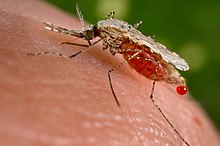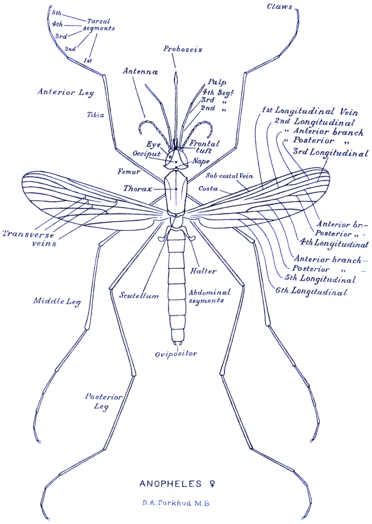Anopheles
| Anopheles | |
|---|---|

| |
| Anopheles stephensi, female | |
| Scientific classification | |
| Domain: | Eukaryota |
| Kingdom: | Animalia |
| Phylum: | Arthropoda |
| Class: | Insecta |
| Order: | Diptera |
| Family: | Culicidae |
| Subfamily: | Anophelinae
|
| Genus: | Anopheles Meigen 1818 |
| Species | |
|
For a full description, see the main article: Taxonomy of Anopheles | |
Anopheles (
The Anopheles genus diverged from the
Evolution
Fossil history
Fossils of the Anopheles genus are rare; only two had been found by 2015.[2] They are Anopheles (Nyssorhynchus) dominicanus Zavortink & Poinar in Dominican Republic amber from the Late Eocene (40.4 million years ago to 33.9 million years ago),[3] and Anopheles rottensis Statz in German amber from the Late Oligocene (28.4 million years ago to 23 million years ago).[2]
Phylogeny
The ancestors of all flies including mosquitoes appeared 260 million years ago.[4] The culicine and Anopheles clades of mosquitoes diverged between 120 million years ago and 150 million years ago.[4][5] The Old and New World Anopheles species subsequently diverged between 80 million years ago and 95 million years ago.[4][5] Anopheles darlingi diverged from the African and Asian malaria vectors ~100 million years ago.[6] The cladogram is based on an analysis of mosquito genomes by Heafsey and colleagues in 2015:[6]
Diptera
|
| ||||||||||||||||||||||||||||||||||||||||||
| 260 mya
|
Taxonomy
The genus Anopheles was introduced by the German entomologist Johann Wilhelm Meigen in 1818. He described two species, A. birfurcatus and the type species, Anopheles maculipennis. He stated that the name of the genus meant beschwerlich, "burdensome".[7] The name comes from the Ancient Greek word ἀνωφελής anōphelḗs 'useless', derived from ἀν- an-, 'not', 'un-' and ὄφελος óphelos 'profit'.[8]
The taxonomy of the genus was greatly advanced in 1901 when the English entomologist
Anopheles (with a nearly worldwide distribution) belongs to the subfamily
Life cycle
Like all mosquitoes, anophelines go through four stages in their life cycles:
Eggs

Adult females lay 50–200 eggs per
Larvae
The mosquito larva has a well-developed head with mouth brushes used for feeding, a large
Larvae develop through four stages, or
-
Anopheles larva
-
Feeding position of an Anopheles larva (A), culicine larva with its siphon (B)
Pupae
The pupa (also known as a tumbler) is comma-shaped when viewed from the side. The head and
-
A. maculipennis pupa, breathing at the surface
Adults

Like all mosquitoes, adult Anopheles species have slender bodies with three sections: head, thorax and abdomen. The head is specialized for acquiring sensory information and for feeding. It contains the eyes and a pair of long, many-segmented antennae. The antennae are important for detecting host odours, as well as of breeding sites where females lay eggs.[16] Female mosquitoes carrying Plasmodium parasites, the causative agents of malaria, are significantly more attracted to human breath and odours than uninfected mosquitoes.[17] The head has an elongated, forward-projecting
Anopheles can be distinguished from other mosquitoes by the
Males live for about a week, feeding on nectar and other sources of sugar. Males cannot feed on blood, as it appears to produce toxic effects and kills them within a few days, around the same lifespan as a water-only diet.[18] Females feed on sugar sources for energy, but usually require a blood meal for the development of eggs. After obtaining a full blood meal, the female rests for a few days while the blood is digested and eggs are developed. This process depends on the temperature, but usually takes 2–3 days in tropical conditions. Once the eggs are fully developed, the female lays them and resumes host-seeking. The cycle repeats itself until the female dies. While females can live longer than a month in captivity, most do not live longer than one to two weeks in nature. Their lifespans depend on temperature, humidity, and their ability to successfully obtain a blood meal while avoiding host defenses.[16]
-
Morphology of female Anopheles
Ecology
Distribution
Anopheles species live both in tropical areas known for malaria such as sub-Saharan Africa, and in colder latitudes. Indeed, malaria outbreaks have in the past occurred in colder climates, for example during the construction of the Rideau Canal in Canada during the 1820s.[19] Anopheles species that can transmit malaria are not limited to malaria-endemic areas, so areas where they have been eliminated are constantly at risk of reintroduction of the disease.[20]

Habitat
Anopheles mosquitoes require bodies of water, possibly small and seasonal, for their aquatic larvae and pupae. Suitable habitats range from ponds to water tanks, swamps, ditches and puddles.
Parasites
Parasites of Anopheles include Microsporidia of the genera Amblyospora, Crepidulospora, Senoma and Parathelohania.[24] Two distinct life cycles are found in the Microsporidia. In the first type, the parasite is transmitted by the oral route and is relatively species nonspecific. In the second, while again the oral route is the usual route of infection, the parasite is ingested within an already infected intermediate host. Infection of the insect larval form is frequently tissue-specific, and commonly involves the fat body. Vertical (transovarial) transmission also occurs.[25]
The parasitic Wolbachia bacteria have been studied for use as control agents.[26]
Predators
The jumping spider Evarcha culicivora indirectly feeds on vertebrate blood by preying on female Anopheles mosquitos.[27] Juvenile spiders choose the Anopheles over all other prey regardless of whether it actually is carrying blood.[28] Juvenile spiders have adopted an Anopheles-specific prey-capture behavior, using the posture of Anopheles mosquitoes as a primary cue to identify them.[27] Anopheles has a distinctive resting posture with its abdomen angled up. In this case, the spider approaches from behind the mosquito and under its abdomen, and then attacks from below.[29]
Malaria vectors
Preferred sources for blood meals
Since the genus Anopheles is the sole vector for malaria, it has been studied intensively in the search for effective control methods. One important behavioral factor is the degree to which an Anopheles species prefers to feed on humans (
Probability of transmitting malaria
Once ingested by a mosquito, malaria parasites must undergo development within the mosquito before they are infectious to humans. The time required for the parasite to develop in the mosquito (the extrinsic incubation period) ranges from 10–21 days, depending on the parasite species and the temperature. If a mosquito does not survive long enough for the parasite to develop, then she transmits no parasites.[16]
It is not possible to measure directly the lifespans of mosquitoes in nature, but indirect estimates of daily survivorship have been made for several Anopheles species. Estimates of daily survivorship in
Patterns of feeding and resting
Most Anopheles mosquitoes are
Gut flora
Because transmission of disease by the mosquito requires ingestion of blood, the gut flora may have a bearing on the success of infection of the mosquito host. The larval and pupal gut is largely colonized by photosynthetic cyanobacteria, while in the adult, gram-negative bacteria in the Pseudomonadota and Bacteroidota phyla predominate. Blood meals drastically reduce the diversity of microorganisms in the gut, favouring bacteria.[33]
Control
Insecticide control and resistance
Insecticides have offered a first line of approach to ridding areas of malarial mosquitoes. However, mosquitoes, with a short generation time, may rapidly evolve resistance, as experienced during the Global Malaria Eradication Campaign of the 1950s.[34] The use of insecticides in agriculture has resulted in resistance in mosquito populations, implying that an effective control program must monitor for resistance and switch to other means if resistance is detected.[35]
Eradication
In 2016, a CRISPR-Cas9 gene drive system was proposed to eradicate Anopheles gambiae,[36] by deleting the dsx gene, causing female sterility. Such a gene drive system has been shown to suppress an entire caged A. gambiae population[37] within 7–11 generations, typically less than a year. This has raised concerns with both the efficiency of a gene drive system as well as the ethical and ecological impact of such an eradication program.[38] Therefore, there have been efforts to use the gene drive system to more efficiently introduce genes of Plasmodium resistance into the species, such as targeting and knocking out the FREP1 gene in Anopheles gambiae.[39] Researchers in Burkina Faso have created a strain of the fungus Metarhizium pinghaense that is genetically engineered to produce the venom of an Australian funnel-web spider; exposure to the fungus caused populations of Anopheles mosquitoes to crash by 99% in a controlled trial.[40]
See also
References
- ^ "Nail Mosquito". United States Fish and Wildlife Service. Retrieved 16 December 2023.
Common Name: Nail Mosquito, marsh mosquitoes
- ^ PMID 26244561.
- S2CID 86221732.
- ^ PMID 20470395.
- ^ PMID 19178717.
- ^ PMID 25554792.
- ^ Meigen JW (1818). Systematische Beschreibung der bekannten Europäischen zweiflügeligen Insekten [Systematic description of the known European two-winged insects] (in German). Vol. 1. Aachen: Friedrich Wilhelm Forstmann. pp. 10–12.
- ISBN 978-0-19-957112-3.
- ISBN 978-1-178-51903-7.
- ^ S2CID 46364692.
- PMID 12208816.
- PMID 9562985.
- PMID 17262930.
- PMID 16782411.
- S2CID 22776177.
- ^ a b c d e f g h i j k l m
 This article incorporates text from this source, which is in the public domain: "Anopheles Mosquitoes". Centers for Disease Control and Prevention. October 21, 2015. Retrieved December 21, 2016.
This article incorporates text from this source, which is in the public domain: "Anopheles Mosquitoes". Centers for Disease Control and Prevention. October 21, 2015. Retrieved December 21, 2016.
- PMID 23691073.
- PMID 26858651.
- S2CID 143040362.
- ^ a b "CDC - Malaria - About Malaria - Where Malaria occurs". cdc.gov. April 9, 2020. Retrieved December 20, 2022.
- ^ "Anopheles Mosquitoes". Global Vector Hub. Retrieved 15 December 2023.
- PMID 36470782.
- PMID 32429218.
- PMID 18664069.
- PMID 9538024.
- ^ "Mosquito Parasite Fights Infectious Disease". Discovery News. 1 October 2009. Archived from the original on 23 November 2009.
- ^ S2CID 55244513.
- ^ Jackson, Robert R.; Cross, Fiona R. "Mosquito-terminator spiders and the meaning of predatory specialization." The Journal of Arachnology 43.2 (2015): 123–142.
- PMID 17205136.
- ISBN 0-520-02638-1.
- PMID 2774063.
- .
- PMID 21957459.
- ^ Najera JA (1999). "Malaria Control: Achievements, Problems, & Strategies" (PDF). World Health Organization. Retrieved 23 January 2024.
- ^ "Biology: Anopheles Mosquitoes (tab 5)". Centers for Disease Control and Prevention. 16 July 2020. Retrieved 16 December 2023.
- PMID 26641531.
- PMID 30247490.
- PMID 28108316.
- PMID 29518156.
- ^ Gallagher J (31 May 2019). "GM fungus rapidly kills 99% of malaria mosquitoes, study suggests". BBC News Online. Retrieved 31 Dec 2019.
External links
- Anopheles Database
- Anopheles gambiae Genome and Related Data Archived 2012-12-03 at the Wayback Machine
- CDC – National Center for Infectious Diseases, Division of Parasitic Diseases; Malaria
- CDC – World map showing distribution of various Anopheles species
- Walter Reed Biosystematics Unit. – Links to the online mosquito catalog, keys for mosquito identification, images and information on medically important species and much more.
- Malaria Atlas Project
- Anopheles gambiae taxonomy, facts and life cycle
- Anopheles quadrimaculatus, common malaria mosquito on the University of Florida / Institute of Food and Agricultural Sciences Featured Creatures website
- http://animaldiversity.ummz.umich.edu/site/accounts/classification/Anopheles.html





